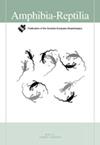Local scale population risk determines the adaptive responses of larval salamanders to predator kairomones
IF 1.3
4区 生物学
Q3 ZOOLOGY
引用次数: 0
Abstract
Abstract Organisms can exhibit plasticity in phenotypic responses to environmental stimuli but the response can vary based on the evolutionary history of a population. Numerous studies have found that prey will express adaptive responses when subjected to various predators in experimental settings. For species with a large distribution, such as Ambystoma maculatum (spotted salamander), it is not surprising that phenotypic variance can be high across their range. This variance has been hypothesized to be because of different predator regimes of populations. While A. maculatum preferentially oviposit eggs in low-risk ponds (temporary fishless) to decrease egg and larval mortality, Missouri populations still use high-risk ponds (permanent with fish) for reproduction. Using a series of experiments, we investigated how A. maculatum population risk influenced adaptive responses to both native and novel predator kairomones. For natural predators, we used larval A. opacum (marbled salamanders) and Lepomis macrochirus (bluegill) and for novel predators we used Siren intermedia (lesser siren). We found that larval salamanders generally responded with no differences in morphological traits to all three predators. However, head width was larger for low-risk populations. One hypothesized benefit of larger heads (increased foraging efficiency) was not fully supported. All larval salamanders also increased refuge use with predators but this decreased over time. Our results suggest that predation risk of a population may influence the degree of phenotypic expression in response to larval predators. Overall, local adaptation may dictate the ability of prey to respond to environmental conditions within a life stage.局部规模的种群风险决定了蝾螈幼虫对捕食者激素的适应性反应
生物体对环境刺激的表型反应具有可塑性,但这种反应可以根据种群的进化史而变化。大量研究发现,在实验环境中,猎物在面对不同的捕食者时会表现出适应性反应。对于分布较大的物种,如斑点蝾螈(Ambystoma maculatum),在其分布范围内,表型差异可能很高,这并不奇怪。据推测,这种差异是由于不同种群的捕食者制度造成的。虽然斑纹夜蛾优先在低风险池塘(暂时无鱼)产卵以降低卵和幼虫的死亡率,但密苏里州的种群仍然使用高风险池塘(永久有鱼)进行繁殖。通过一系列实验,我们研究了黄斑田鼠种群风险如何影响其对原生和新型捕食者kairomones的适应性反应。对于自然捕食者,我们使用了A. opacum(大理石蝾螈)和Lepomis macrochirus(蓝鳃鱼)的幼虫,对于新型捕食者,我们使用了Siren intermedium(小海妖)。我们发现,蝾螈幼虫对这三种捕食者的形态特征总体上没有差异。然而,低风险人群的头宽更大。一个假设的好处(提高觅食效率)是不完全支持的。所有的蝾螈幼虫也增加了捕食者的避难所,但随着时间的推移,这种情况有所减少。我们的研究结果表明,一个种群的捕食风险可能影响表型表达的程度,以应对幼虫捕食者。总的来说,局部适应可能决定了猎物在一个生命阶段对环境条件的反应能力。
本文章由计算机程序翻译,如有差异,请以英文原文为准。
求助全文
约1分钟内获得全文
求助全文
来源期刊

Amphibia-Reptilia
生物-动物学
CiteScore
3.10
自引率
6.20%
发文量
39
审稿时长
6-12 weeks
期刊介绍:
Amphibia-Reptilia is a leading European multi-disciplinary journal devoted to most of the aspects of herpetology: ecology, behaviour, evolution, conservation, physiology, morphology, paleontology, genetics, and systematics.
Amphibia-Reptilia publishes high quality original papers, short-notes, reviews, book reviews and news of the Societas Europaea Herpetologica (SEH). The Societas Europaea Herpteologica (SEH) website is located at: www.seh-herpetology.org.
 求助内容:
求助内容: 应助结果提醒方式:
应助结果提醒方式:


